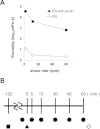Fluorescence imaging in vivo visualizes delayed gastric emptying of liquid enteral nutrition containing pectin
- PMID: 25263497
- PMCID: PMC4182873
- DOI: 10.1186/1471-230X-14-168
Fluorescence imaging in vivo visualizes delayed gastric emptying of liquid enteral nutrition containing pectin
Abstract
Background: Semi-solidification by gelation or increased viscosity could slow the influx of liquid enteral nutrition (EN) into the small intestine. A liquid EN formula containing pectin that gels under acidic conditions such as those found in the stomach has been developed. A new near-infrared fluorescent imaging reagent was used to non-invasively acquire real time images of gastric emptying in a murine model in vivo. We postulated that the EN formula delays gastric emptying and tested this hypothesis using imaging in vivo.
Methods: Male BALB/c mice were given an oral bolus injection of a liquid EN containing the fluorescence reagent GastroSense750 with or without pectin. The EN in the stomach was visualized in vivo at various intervals using a non-invasive live imaging system and fluorescent signals were monitored from the stomach, which was removed at 60 min after EN ingestion.
Results: The fluorescence intensity of signals in stomachs in vivo and in resected stomachs was lower and attenuated over time in mice given EN without, than with pectin.
Conclusions: Adding a gelling agent such as pectin delayed the transit of liquid EN from the stomach. Fluorescence imaging can visualize the delayed gastric emptying of EN containing pectin.
Figures




Similar articles
-
High-viscosity liquid meal accelerates gastric emptying.Neurogastroenterol Motil. 2007 Nov;19(11):879-86. doi: 10.1111/j.1365-2982.2007.00972.x. Neurogastroenterol Motil. 2007. PMID: 17973639 Clinical Trial.
-
Effect of pectin on gastric emptying and gastroduodenal motility in normal subjects.Gastroenterology. 1987 Feb;92(2):486-92. doi: 10.1016/0016-5085(87)90146-6. Gastroenterology. 1987. PMID: 3539692
-
Gastric Emptying in Critically Ill Children.JPEN J Parenter Enteral Nutr. 2017 Sep;41(7):1100-1109. doi: 10.1177/0148607116686330. Epub 2017 Jan 6. JPEN J Parenter Enteral Nutr. 2017. PMID: 28061320
-
Pectin delays gastric emptying.Nutr Rev. 1989 Sep;47(9):268-70. doi: 10.1111/j.1753-4887.1989.tb02860.x. Nutr Rev. 1989. PMID: 2689931 Review.
-
[Health-promoting properties of pectin].Postepy Hig Med Dosw (Online). 2014 Jan 2;68:590-6. doi: 10.5604/17322693.1102342. Postepy Hig Med Dosw (Online). 2014. PMID: 24864109 Review. Polish.
Cited by
-
Food Ingredients That Inhibit Cholesterol Absorption.Prev Nutr Food Sci. 2017 Jun;22(2):67-80. doi: 10.3746/pnf.2017.22.2.67. Epub 2017 Jun 30. Prev Nutr Food Sci. 2017. PMID: 28702423 Free PMC article. Review.
-
Fecal imaging demonstrates that low-methoxyl pectin supplementation normalizes gastro-intestinal transit in mice given a liquid diet.Physiol Rep. 2018 Apr;6(7):e13662. doi: 10.14814/phy2.13662. Physiol Rep. 2018. PMID: 29611327 Free PMC article.
-
Probing the modulated formation of gold nanoparticles-beta-lactoglobulin corona complexes and their applications.Nanoscale. 2017 Nov 23;9(45):17758-17769. doi: 10.1039/c7nr02999c. Nanoscale. 2017. PMID: 28869274 Free PMC article.
References
-
- Hunt JN, Knox MT. Regulation of Gastric Emptying. In: Code CF, Heidel W, editors. Handbook of Physiology. Washington DC: American Physiological Society; 1968. pp. 1917–1935.
-
- Vecht J, Masclee AA, Lamers CB. The dumping syndrome. Current insights into pathophysiology, diagnosis and treatment. Scand J Gastroenterol Suppl. 1997;223:21–27. - PubMed
-
- Zaloga GP, Chernow B. Postprandial hypoglycemia after Nissen fundoplication for reflux esophagitis. Gastroenterology. 1983;84:840–842. - PubMed
Pre-publication history
-
- The pre-publication history for this paper can be accessed here:http://www.biomedcentral.com/1471-230X/14/168/prepub
MeSH terms
Substances
LinkOut - more resources
Full Text Sources
Other Literature Sources
Research Materials

